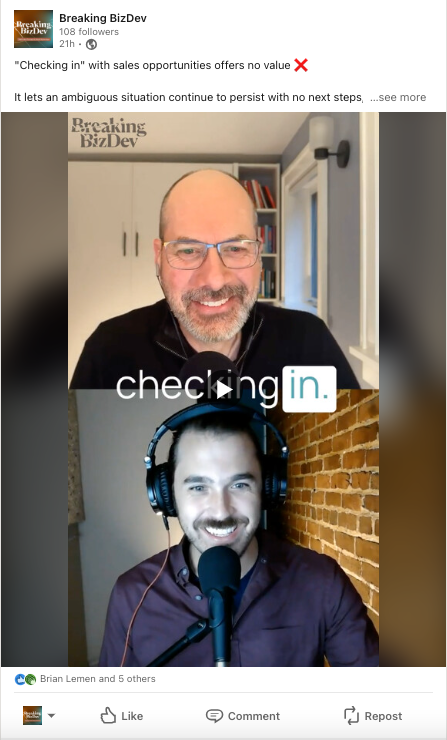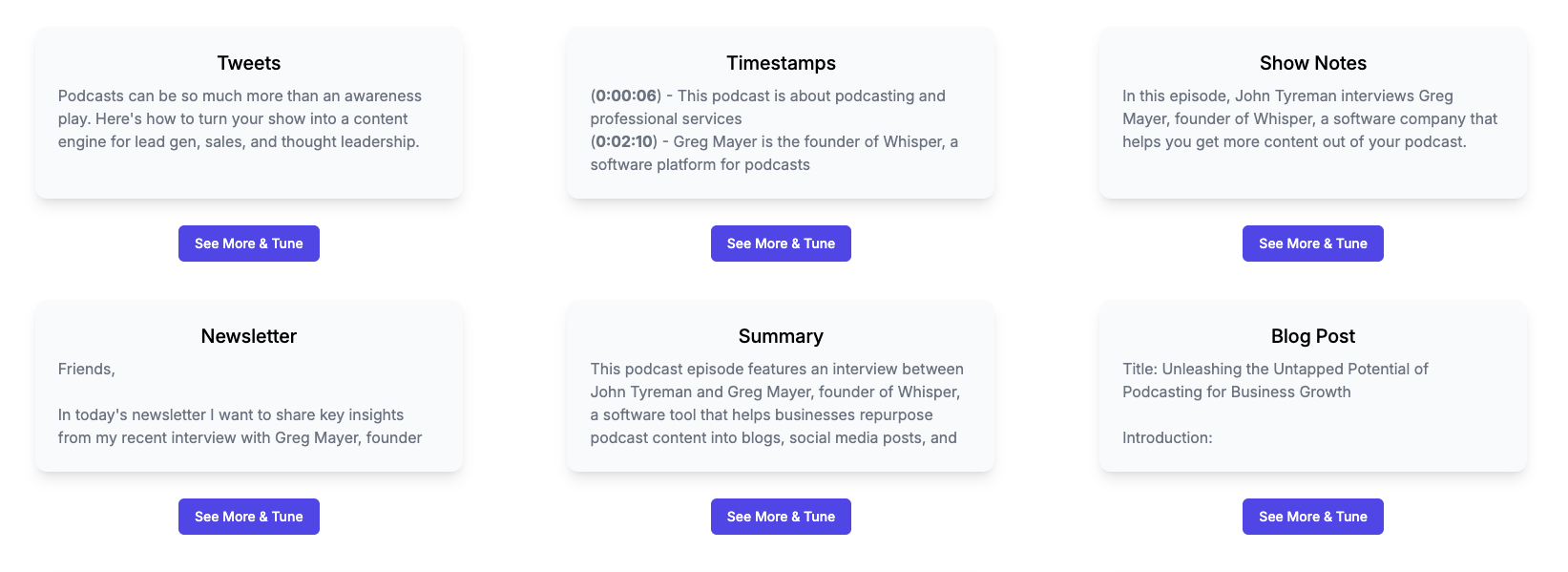Content Repurposing: Get More Out of Your Podcast, With Greg Mayer of Wysper
In the world of professional services, buyers need to consume a lot of information in order to make the best purchase decision. One of the many challenges of marketing is figuring out how to package that valuable information in a way that buyers will consume. This practice is known in the marketing community as content repurposing.
Firms who have an existing company podcast have a distinct advantage. When marketed properly, one podcast episode can be repurposed into dozens of other content assets.
But content repurposing can be a major challenge, especially for firms with smaller marketing teams and budgets. In order to remain efficient, professional services marketers will need to rely on marketing technology and software platforms to build the frameworks and processes needed to do content repurposing effectively.
On a recent episode of Podcasting in Professional Services, I interviewed Greg Mayer, Founder of Wysper, a software platform that turns audio files into a range of formatted text content. Greg and I talked about the importance of repurposing podcast content, the role of AI, and ways to turn other kinds of audio (webinars, customer interviews, etc.) into text-based content. Listen to my full conversation with Greg here:
Content Repurposing: Get More Out of Your Podcast
Human behavior can be hard to quantify. It changes with the environment, and is influenced by many different factors. When it comes to professional services marketing, long sales cycles mean buyers do a lot of research. How do they do their research? Consuming content.
Every few months, I run a (very un-scientific) poll on LinkedIn where I pose a question, “What’s your preferred way to consume information?” Each time I get split results:
If this represents how most buyers buy, then professional services marketers are in trouble. Posting a monthly blog and weekly LinkedIn post is not enough to move the needle. Even if the content is focused on the challenges your buyers solve, there is friction for buyers if they cannot consume information in their preferred format.
This tells me that in industries like accounting, architecture, engineering, and consulting, marketing needs a gut-check. These types of businesses are driven by expertise. So how can expert-driven content be packaged into audio, video, and text-based formats efficiently?
The Podcast Flywheel
I wrote about seven different content marketing frameworks companies can use to generate leads. One of them I like to call the Podcast Flywheel, illustrated below.
By treating a podcast as the source of your content strategy, you are able to package up the same insights into different formats, efficiently. One podcast episode could turn into dozens of content assets. Over time, you will have a library of educational material to fuel search, social, sales enablement, and other parts of your marketing strategy.
The best part? Content repurposing is only one of the benefits of podcasting for business. A podcast can have a major impact on networking, lead generation, and even attracting and retaining top talent.
Enable Sales Conversations with Podcast Media
Podcasts are an incredible way to build awareness within a target, niche audience. This can be a powerful asset for businesses with long sales cycles, like professional services firms. However, in today’s business environment, principles, partners, and business owners feel pressure to realize faster returns on their marketing investments.
“Podcasts are a fantastic way to build awareness in your market with 95% of folks that aren't ready to buy yet.” Said Greg. “You can spend a year warming up the market, building your credibility and awareness. But in today's market, where a merciless CFO is looking at cutting marketing costs… They're not going to care.”
One way to show the impact on revenue in the early stages of a podcast is to use podcast content to enable sales conversations. For example, expert doer-sellers could share a specific conversation with a prospect, an existing client, or an opportunity with an outstanding proposal to try to get movement.
Fuel SEO With Podcast Media
Transcripts can fuel editorial SEO for informational keywords. In other words, a podcast can fuel your blog content. Just like this post! I should note that in my experience I haven’t found much success copying/pasting episode transcriptions onto a webpage. However, when you pull quotes from a transcript, it helps fill out the content on a page.
“I spoke to someone recently that was ahead of the game, but they were doing it manually.” Said Greg. He went on to describe a process of cleaning up a raw transcript, then repurposing the transcript into a keyword-optimized blog post that boosted SEO metrics dramatically over the course of a quarter. “And so they were able to just take the podcast and say, like, hey, look, we drove all this SEO traffic, and now that's our number one channel.”
As a personal aside, I’ve been using podcast media to fuel my own SEO strategy. It’s been about four months since I started doing this, but I’m starting to see results.
Fill Up Your Social Media Calendars
If your company runs a podcast, there should be no shortage of content for social media channels like LinkedIn, X, or even YouTube. Think about it. New followers or subscribers today probably didn’t see or hear the content you published last month. So, you’ll need to work that content into regular promotion cycles.
Each time you produce a new episode, you should also create 2-3 short video snippets for social media. Let’s say your podcast publishes an episode every other week. After 3 months of running your podcast, you should have 12-18 short video snippets that you can start to work into next quarter’s content calendar. Over time, this gives you a library of social media content that can help you maintain a consistent publishing frequency.
Breaking BizDev, another podcast I co-host with Mark Wainwright, uses a LinkedIn showcase page as a media channel. At first, we posted one video each week for new episodes. After a few months, we built up a library of video assets. We got to a point where we could regularly publish 2x per week. Over time, I expect publishing frequency to increase, along with impressions, video views, and episode downloads. Click on the image below to see one of these posts, or check out the LinkedIn page to follow along.
Wysper: Turning Podcasts Into Content Engines
Greg Mayer, an avid podcast listener and product marketer, saw an opportunity in his day job to build a software product that helps podcasters and marketers get more content out of their podcast. Having worked as a product marketer at Gong, Greg saw first-hand the power of transcription.
“For a long time, [Gong’s] transcription was the best that you could get.” Greg said. “Then I saw some of these AI transcription models coming out while everyone was distracted by ChatGPT, and was like, ‘how can I use this in my day job?’ And that was the use case that kept popping into my mind, and I was testing it out, building prototypes, and it worked.”
In 2023, Greg launched Wysper, a software platform that allows you to upload an audio file, then it produces a range of text-based outputs like Tweets, timestamps, show notes, newsletters, summaries, and blog posts. Below is a screenshot from my account when I used Wysper to help produce this blog post and show notes 🤯
Personally, I’m finding this tool to be incredibly useful as a podcaster/marketer. I understand the challenges of doing content distribution effectively. It requires a lot of work, and tools like Wysper make it easier.
Finding a Balance Between Consuming and Creating
Why create such a tool? This is where I find Greg’s perspective interesting. Not only is he a marketer, but he’s also a prototypical podcast consumer. He represents about 24% of U.S. adults who listen to podcasts weekly, according to Infinite Dial—a number that continues to grow year-over-year.
“I consume a ton of podcasts.” Said Greg. “I'm that annoying friend that's like, ‘you need to listen to this two and a half hour podcast episode when you just happen to have two and a half hours.’ I love to walk, run, cycle and all those things. And I'm always consuming [podcasts] during that alone time.”
When you’re on a growth track—as an individual or as a company—it’s likely there is a lot you don’t know and need to find out. Podcasts are a great way to get new ideas. In fact, according to a December 2022 survey of 5,132 U.S. adults (18+) by Pew Research, a full 55% of podcast consumers say that “learning” is a major reason for listening, second only to “entertainment” at 60% of respondents.
While consuming information is important, it must be applied in order to grow. At one point, Greg found himself out of balance. He needed to consume less and apply what he learned by listening to podcasts.
“Work is making things and doing things and getting things done and crossing things off lists. And in order to be good at that, you need to consume content in your arena, in your space, in your industry. Things that inspire you, things that help you learn new trends. But that's not the work. And you need to make sure that you don't confuse those two things.”
Get Started With Podcast Content Repurposing
Need help navigating the podcasting waters? I can help. I’m not just a podcast producer. When you work with me, you get a strategic partner — someone who has industry knowledge and experience with podcast production, content marketing, and operating digital platforms. Simply reach out to learn more about how I help professional services firms use podcast media to grow their business.





